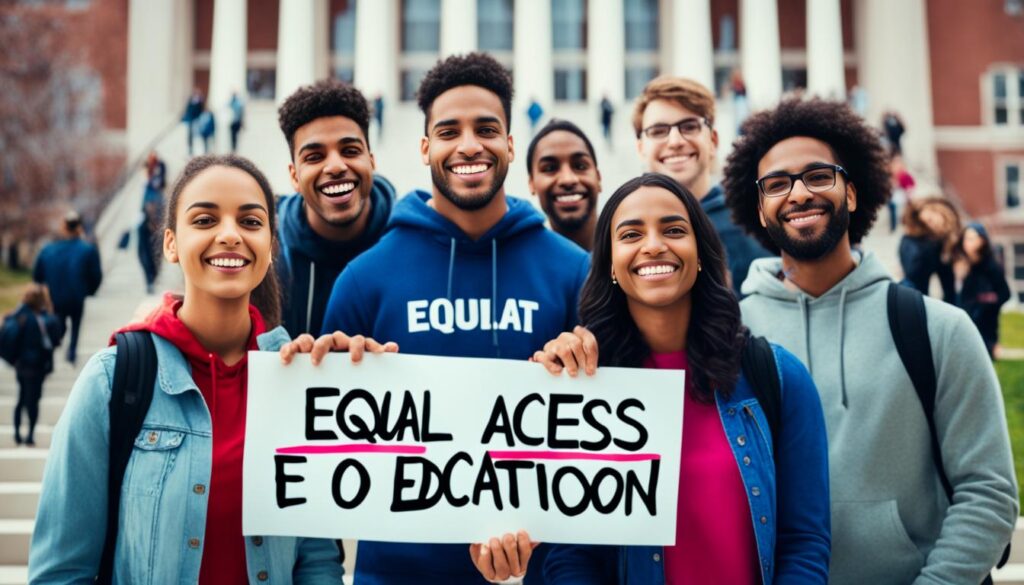How can Surinamese students ascend to heights of academic success and secure pivotal positions in the global employment sphere? This ponderance often frequents the minds of Surinamese students, contemplating pathways for career progression, accessible education, and professional growth avenues. This discourse aims to elucidate pivotal strategies and initiatives that could significantly enhance the academic and professional trajectories of Surinamese students.
Embracing novel methodologies, collective endeavors, and the strategic application of technological advancements could serve as the catalysts for Surinamese students to surmount educational barriers and attain academic and vocational distinction. This encompassing compendium is designed to furnish you with essential tools and discernments, empowering your scholastic voyage.
Key Takeaways:
- Discover strategies for closing equity gaps and promoting social mobility in Surinamese higher education.
- Learn how to leverage technology to enhance learning and access resources for academic success.
- Understand the importance of collaboration and support services in helping Surinamese students excel.
- Explore tips for maximizing online learning and navigating the challenges of remote education.
- Find out how to prioritize higher education affordability and maximize financial support opportunities.
Defining Student Success in Higher Education
The paradigm of student success in higher academia has transcended mere graduation rates and GPA metrics to include broader elements that are integral to a student’s comprehensive well-being and future readiness.
Recognizing that academic accomplishments remain critical, institutions of higher learning now also valorize the importance of mental and physical wellness, economic stability, and vocational preparedness in sculpting a student’s life post-graduation.
“Student success has expanded from purely academic performance to a holistic conception, considering a student’s general well-being and their competence in navigating the complexities of the real world.”
This comprehensive view of student success enables colleges and universities to provide more effectively for their students, enabling them to reach their ambitions and objectives.
Expanding the Definition of Success
Historically, academic institutions gauged student success through metrics such as graduation rates and GPA. Though these indicators remain crucial, they fall short of encapsulating a student’s entire academic voyage and future opportunities.
- Graduation rates: This denotes the completion of an academic program within a predetermined period.
- GPA scores: This reflects a student’s academic performance over their university tenure.
There is now an acknowledgment that success transcends these numerical indicators. Today, academic institutions also evaluate:
- Mental and physical health: They ensure students can access resources and supports for their well-being.
- Financial security: They provide avenues for financial aids, scholarships, and methods to reduce student debt burdens.
- Job readiness: They prepare students with the necessary competencies and insights to succeed in their professional endeavors.
In expanding the notion of success, academic institutions can more thoroughly prepare their students for post-graduation realities.
The Challenges of a Broadened Definition
Though broadening the student success definition is essential for contemporary student needs, it also introduces complexities for academic leaders. Addressing these diverse and intricate factors demands innovative solutions and a steadfast dedication to student support.
Academic institutions must craft strategies that promote success across various domains, which may include:
- Comprehensive mental health services and well-being initiatives.
- Educational programs focusing on financial literacy and stability.
- Collaborations with industry to provide employment services and internship opportunities.
To further this aim, a nurturing campus culture that elevates student welfare and success across all dimensions is imperative. This involves making resources available, cultivating community, and advocating for inclusiveness.
By confronting these challenges decisively, higher education leaders can forge an ecosystem that propels students towards comprehensive achievements in their personal and professional lives.
Closing Equity Gaps and Improving Social Mobility
To address the myriad challenges faced by low-income students, those of color, and individuals embarking on academia as the first in their families, instituting strategic measures has become crucial for improving student outcomes. Recognizing the critical role of equity gaps and social mobility plays instrumental in sculpting a just, inclusive landscape within higher education. The use of comprehensive data analysis alongside modern student information systems empowers educational institutions with the requisite insights to understand and address the disparities that pervade their student body.
Colleges deploy data analysis to pinpoint where specific student demographics may encounter unique challenges to their academic and social success. Such analytic input is pivotal in crafting targeted interventions. It empowers educational faculties to formulate strategies that are meticulously aligned with the requirements of students historically marginalized.
Through the implementation of these precise interventions, colleges aspire to obliterate equity gaps while enhancing social mobility. A concerted effort to furnish additional backing and resources to students from traditionally underrepresented sects paves the way for a more equitable academic and professional sphere where every student, irrespective of their background, has the potential to flourish.

Addressing equity gaps and improving social mobility are key goals for colleges to ensure that all students, regardless of their background, have an equal chance at success.
Colleges uphold a commitment towards cultivating a culture steeped in student success, characterized by inclusivity where low-income students, those of color, and first-generation learners find themselves in a position to succeed. The ingenuity behind targeted interventions and comprehensive support services lies in the institution’s dedicated pursuit of leveling the playing field. Consequently, these mechanisms are aimed at ensuring students from diverse backgrounds have equitable opportunities to achieve academic and professional excellence.
Leveraging Technology for Student Success
Technology plays a pivotal role in enabling student empowerment and success within higher academic realms. By deploying a variety of technological tools and resources, institutions of higher learning can equip their students with the requisite support, knowledge, and services. This comprehensive provision facilitates both academic excellence and personal prosperity. We shall delve into several critical manners through which technology bolsters student success:
Analytics-Based Insights
Advanced technological systems afford educational institutions the capability to gather and scrutinize extensive data sets pertaining to student engagement, performance, and progression. Such analytics-driven insights yield invaluable data. This data can initiate personalized intervention strategies. By discerning the individual strengths, deficiencies, and educational predilections of students, educators can customize their pedagogical tactics. This fosters personalized growth and triumphs.
Flexible Learning Models
The advent of online learning infrastructures, interactive instructional software, and digital classrooms ushers in versatile educational models. These models accommodate the variegated prerequisites of a diverse student body. Through technology, learners avail themselves of the liberty to access instructional materials, engage with cohorts, and partake in educational pursuits at their own pace and convenience. Such flexibility augments student engagement, motivation, and, sequentially, their success.
Online Academic Advising
Virtual academic advising is made feasible through technological advancement, offering students unfettered access to advice from seasoned advisors. In these virtual consultations, students articulate their scholarly objectives, strategize their course agendas, and solicit advice on surmounting academic challenges. This modality of academic advisement guarantees that learners are imparted with bespoke guidance. It aids them in making well-informed decisions and maintaining their trajectory towards their ambitions.
Virtual Tutoring
Virtual tutoring portals enable scholars to liaison with adept tutors for specialized support in particular disciplines. Whether the need lies in mathematics, sciences, composition, or an alternate field, virtual tutoring extends flexible and reachable assistance. Learners can orchestrate tutoring engagements aligning with their schedules. This affords them the opportunity to rectify educational deficiencies and deepen their comprehension of intricate subjects.
Career Services and Financial Aid
Technological interventions simplify access to career services and financial aid instruments. Scholars can peruse internships and employment prospects, utilize resume augmentation utilities, and seek career advancement counsel. Moreover, technology optimizes the application and administration of financial aid. This ensures that students procure necessary fiscal resources to further their educational pursuits and mitigate fiscal burdens.
Mental Health Resources
Academic institutions acknowledge the paramountcy of prioritizing the mental health and wellness of their students. Technological avenues provide access to mental health resources, including online counseling, mental health applications, and support networks. These readily accessible resources facilitate students in addressing mental health concerns. This contributes to their overall well-being and scholastic achievement.
Utilizing technology strategically within the sphere of higher education enables institutions to nurture student success. They supply vital resources, individualized backing, and invaluable insights. Through effective technological integration, educational bodies empower learners to navigate obstacles, realize their inherent capabilities, and fulfill their academic and professional aspirations.
Developing a Collaborative Approach to Student Success
To achieve student success, multidisciplinary collaboration is imperative. Departments such as academic advising, career services, tutoring, and financial aid must synergize to furnish exhaustive support. This confluence of resources bestows students with the means to surmount obstacles and realize their ambitions.
Academic advising is a cornerstone in directing students through their scholastic endeavors. Advisors tailor guidance, aid in selecting courses, and help students tackle various adversities. By interlinking with faculty across disciplines, advisors ensure the delivery of extensive academic counsel.
Career services are crucial in prepping students for employment. They synchronize academic curriculums with labor market demands, arming students with requisite skills for career progression. This synergy affords students access to internships, employment services, and networking events, thus bolstering their employability.
Tutoring services augment academic support, nurturing a culture of achievement. In coordination with academic faculties, tutoring sessions offer focused aid, enabling students to surmount educational challenges and better grasp their studies.
Financial aid is vital in underpinning student success. By collaborating cross-departmentally, financial aid offices offer insights into scholarships, grants, and other monetary support. This cooperation reduces the financial strain on students, allowing them to pursue education unfettered.
The involvement of faculty is essential to fostering a student-success culture. Faculty’s active role in support programs and development initiatives advocates for student necessities. Their contribution enriches the academic community, reinforcing a collective dedication to student achievement.

Empowering educational stakeholders with technology is crucial for nurturing student success. The deployment of student information systems enhances communication, facilitates data analysis, and promotes interdepartmental cooperation. This technological backbone equips all parties with the necessary insights for well-informed decision-making and comprehensive student support.
The formation of a collaborative framework incorporating cross-departmental advising, support services, faculty involvement, and an emphasis on student-success culture is instrumental in cultivating an environment where students flourish academically and professionally. Such an initiative not only elevates student achievement rates but also builds a communal sense of responsibility toward student welfare and accomplishments.
Strategies for Enhancing Teaching and Learning
To excel in educational outcomes, a profound comprehension of state learning standards is indispensable for educators. Aligning teaching methodologies with these benchmarks enables the delivery of requisite content and competencies, essential for students’ academic achievements. Thus, it positions students on a trajectory towards success.
The integration of Assessments within the educational framework is paramount. These evaluations offer critical insights into students’ grasps of material, highlighting knowledge deficiencies. Consequently, educators can refine their pedagogical approaches, targeting specific weaknesses, thereby escalating academic progress.
Enhancing student involvement necessitates the implementation of diverse instructional practices. The inclusion of practical activities, collaborative tasks, and applications to real-life scenarios renders the learning process more engaging and pertinent. This strategy not only catalyzes participation but also fosters a vibrant educational milieu, conducive to the absorption and application of knowledge.
The establishment of robust, affirmative relationships between educators and learners is a cornerstone of effective teaching. A supportive and appreciative atmosphere encourages students to partake more earnestly in their educational journey. Personalized interactions, constructive feedback, and unwavering support are fundamental in nurturing such environments.
Key Takeaways:
- Aligning instructional practices with state learning standards enhances teaching and learning.
- Assessments provide valuable feedback and help fill gaps in student knowledge.
- Using instructional practices that promote engagement boosts academic progress.
- Building strong relationships between teachers and students enhances student engagement.
Integrating AI for Student Success
The advent of artificial intelligence (AI) into the educational sphere heralds unprecedented prospects for revolutionizing teaching methodologies and bolstering student accomplishments. Through the deployment of AI-powered computer-based tutors, learners are afforded individually tailored educational journeys across an extensive spectrum of subjects and disciplines.
AI-based instructional coaching emerges as another frontier to bolster student triumphs. Utilizing AI technology allows instructional coaches to dispense precise guidance and support to students, aiding them in overcoming obstacles and embracing innovative teaching methodologies.
Moreover, the incorporation of AI in online learning platforms catalyzes the creation of dynamic, adaptive educational settings. By employing AI algorithms, these platforms are capable of delivering customized content, individualized feedback, and instantaneous evaluations, thus driving superior student engagement and academic results.

The implementation of AI in education aims not to supplant human educators or diminish the indispensability of teacher-student interactions. It seeks to augment the conventional classroom experience, equipping educators with invaluable resources and instruments to advance student accomplishment.
Unlocking the Potential of AI in Education:
- Personalized learning experiences through AI-powered computer-based tutors
- Targeted instructional coaching to support student achievement and innovation
- Dynamic and adaptive online learning platforms aided by AI algorithms
- Enhanced student engagement, feedback, and learning outcomes
As educators and academic institutions venture further into the realm of AI integration, maintaining equilibrium between technology and human touch becomes imperative. By harnessing AI within the educational milieu, we can engender an empowering learning environment that fortifies students, enriches teaching modalities, and cultivates student success.
Tips for Maximizing Online Learning
In the realm of online educational pursuits, a myriad of strategies exist to amplify the overall learning experience, ensuring optimal student achievement. The utilization of virtual platforms, the cultivation of learner engagement, and the personalized educational opportunities are pivotal. These elements collectively facilitate an enriching online educational journey.
Building robust rapport with peers and instructors is crucial. Engagement in virtual discourse, cooperation in group endeavors, and solicitation of assistance when necessary, fosters a sense of belonging within the digital classroom environment. This interconnectedness is instrumental in augmenting the learning experience.
- Build strong relationships with your classmates and instructors. Actively participate in online discussions, collaborate on group projects, and reach out for support when needed. Building connections online can create a sense of community and enhance your learning experience.
- Promote student engagement by staying organized and creating a dedicated study space. Establish a routine, set goals, and manage your time effectively. Actively participate in online discussions, ask questions, and seek clarification to stay engaged with the course material.
- Take advantage of the features and resources offered by your online platform. Familiarize yourself with the learning management system, online libraries, and virtual tutoring services. Explore the interactive tools available, such as discussion boards, quizzes, and multimedia resources.
- Embrace personalized learning experiences by leveraging adaptive learning technologies and resources. Tailor your study approach based on your individual learning style and pace. Take advantage of self-assessment tools to identify areas of improvement and focus your efforts accordingly.
- Seek feedback and communicate regularly with your instructors. Actively participate in online office hours, virtual meetings, and email communication. The guidance and feedback from your instructors will help you stay on track and make the most out of your online learning experience.
“Online learning requires self-discipline and active engagement. By implementing these tips, you can create a rewarding and successful online learning journey.”
Shrewsbury High School is a testament to the successful inception and expansion of online learning initiatives. Their invaluable experiences offer profound insights into overcoming the hurdles and harnessing the vast potential of online education
Prioritizing Higher Education Affordability
The significance of affordability in higher education lies in its direct impact on student achievement. The cost associated with tuition and ancillary expenses stands as an impasse to accessing higher education for numerous aspiring scholars. Nonetheless, academic institutions wield the capability to foreground affordability, thereby democratizing access to higher education.
Academic institutions can mitigate these financial hurdles by proffering financial aid and scholarships. Such support mechanisms enable students to defray the costs associated with tuition, textbooks, and additional essential academic expenditures. In effect, this support dismantles the financial obstacles confronting students from varied socioeconomic backgrounds, rendering higher education a more attainable aspiration.
In parallel, the endeavor to enhance higher education affordability encompasses initiatives aimed at tuition cost reduction. Institutions might consider enacting policies to freeze or decrement tuition fees, introducing programs that offer tuition rebates, or formulating payment schemes characterized by their flexibility. Through these measures, the sphere of higher education expands, becoming accessible to a wider demographic of learners.
Moreover, academic institutions have a pivotal role in curbing student indebtedness by disseminating knowledge and resources conducive to prudent financial decision-making. This initiative can encompass enlightenment on student loans, repayment modalities, and strategies for debt management. Arming students with this knowledge facilitates their navigation through financial commitments, enabling them to invest in their careers unfettered by exorbitant debt burdens.

By placing a premium on higher education affordability, colleges are instrumental in fostering the successes and progression of their students. An accessible higher education sector not only unlocks a plethora of opportunities but also equips scholars with the requisite knowledge and skills for their professional journeys. Endeavors ranging from the provision of financial aid and scholarships to the facilitation of debt management coalesce to forge a more inclusive and economically accessible higher educational landscape.
Promoting Holistic Student Development
The importance of holistic student development transcends mere academic achievement, emphasizing the overall well-being and success of students. It requires comprehensive support mechanisms that encompass more than just the educational sphere. Addressing diverse facets of a student’s life allows academic institutions to foster environments where students can flourish and realize their utmost potentials.
Central to holistic development is the emphasis on mental health. Colleges must recognize the significance of mental well-being by providing accessible mental health services and counseling programs. Such a support framework is instrumental in assisting students to overcome adversities and develop resilience.
Equally fundamental to student development are well-being programs. These initiatives aim at inculcating healthy lifestyles, effective stress management, and self-care among students. Incorporating physical fitness activities, mindfulness practices, and stress management workshops empowers students to place a precedence on their health.
Extracurricular activities constitute a critical component of holistic development. Participation in clubs, sports, and volunteer work enables students to pursue various interests, hone leadership abilities, and establish significant peer connections. These activities are pivotal for personal growth and fostering a sense of community among students.
Social-emotional learning stands at the core of holistic student development. Integrating it into the academic curriculum equips students with vital life skills, including self-awareness, empathy, and sound decision-making. Cultivating these skills is essential for maintaining healthy relationships, emotional regulation, and navigating life’s myriad challenges.
In essence, holistic student development encompasses a multifaceted approach aimed at addressing the mental, physical, and emotional well-being of students. By weaving together mental health initiatives, wellness programs, extracurricular pursuits, and social-emotional learning, colleges lay the groundwork for students to succeed both academically and in their personal lives.
Strategies for Career Advancement
A pivotal element of higher education’s efficacy lies in career advancement programs. These initiatives, offered by colleges, are tailored to ready students for illustrious careers. They focus on the development of applicable skills, establishment of industry connections, and comprehension of the job market’s dynamics. Such strategies are instrumental for students aiming to augment their professional trajectory and secure gainful employment.

Gaining Practical Experience through Internships
Internships stand as invaluable junctures for students to immerse in professional environments. These placements not only facilitate the application of theoretical knowledge in tangible tasks but also aid in the honing of necessary competencies. Furthermore, they serve as conduits for building a substantial network within the industry. Engaging in internships allows students to peruse diverse career avenues and refine their objectives for the future.
Accessing Job Placement Services
Institutions frequently extend job placement assistance, aiding graduates in their employment quest. These services encompass a spectrum of tools and advice for efficacious job hunting, from crafting compelling resumes to mastering interviews. Engaging with these resources enables students to uncover potential job prospects, thereby enhancing their prospects of embarking on gratifying career paths.
Expanding Networking Opportunities
The essence of networking in career advancement cannot be overstated. Academic institutions engineer events and forums enabling students to mingle with professionals and industry luminaries. Such interactions not only broaden one’s professional network but also furnish insights into diverse sectors and foster mentorships. This exposure can unlock opportunities for pivotal internships and job offers, enriching one’s career outlook.
Cultivating Industry Partnerships
In an endeavor to streamline students’ career success, colleges forge alliances with the corporate realm. These collaborations might manifest as joint projects, lecture series by industry veterans, or curricula that resonate with current market requisites. This synergy ensures curricular relevance to industry needs, arming students with the acumen and skill set sought by employers.
Colleges, by championing career advancement frameworks, play a crucial role in facilitating students’ professional growth. Initiatives like internships, job placement assistance, networking events, and corporate collaborations collectively scaffold students’ journey. They equip them with the tools necessary for not just navigating but excelling in the competitive professional sphere.
Enhancing Student Support Services
The significance of bolstering student support services in higher institutions cannot be overstated for the advancement of student success. Comprehensive support systems are indispensable, enabling colleges to cater to the multifaceted needs of their student body. This, in turn, ensures the well-being and academic advancement of students. Core to these efforts are several critical student support services:
- Academic Advising: Tailored to aid students in navigating their academic trajectory, academic advising services provide counsel on course selection and goal setting. Advisors play a pivotal role, guiding students through informed decision-making processes and the formulation of personalized academic strategies that resonate with their vocational ambitions.
- Counseling Services: Mental health support rendered by counseling services is fundamental in assisting students to manage stress and confront challenges, thereby enhancing their emotional stability. The accessibility to professional counsellors offers a conduit for students seeking advice and formulating personal development tactics.
- Disability Services: Ensuring equal access and accommodations for students with disabilities, disability services foster an inclusive educational ambiance. They deploy specialized support, adaptive technologies, and individualized accommodations, addressing the specific necessities of each student.
- Peer Mentoring: Peer mentoring schemes, pairing seasoned students with newcomers, cultivate a nurturing community. These mentors, as exemplars, dispense invaluable advice and encouragement, facilitating both academic and personal guidance.
- Campus Resources: The provision of campus resources is pivotal to the scholastic achievement of students. Such resources — encompassing libraries, writing centers, and tutoring services, among others — offer a plethora of opportunities for knowledge expansion and participation in extracurricular endeavors.
It is paramount for educational establishments to prioritize investments in student support services. This commitment is instrumental in forging a conducive and supportive learning environment where students are positioned to excel. The amplification of these services unequivocally affirms a college’s dedication to the comprehensive success and well-rounded development of its students.
Quote: “Access to comprehensive support services is pivotal in empowering students to overcome challenges, reach their full potential, and thrive in their academic pursuits.” – [Author Name]
Through the deployment of services like academic advising, counseling, and disability support, along with peer mentoring and access to variegated campus facilities, colleges sculpt a robust network. This network underpins students in both their academic endeavors and personal development, furnishing them with the tools to surmount challenges, hone crucial competencies, and fully leverage their collegiate experience.
Importance of Faculty Engagement
Faculty engagement is pivotal in enhancing student success, necessitating active faculty participation in discussions and the decision-making process concerning student success initiatives. Such engagement fosters a conducive learning atmosphere by bolstering both the teaching and learning experience. Integral to this dynamic is the provision of professional development opportunities for faculty members. This empowers them to remain abreast of educational best practices and refine their pedagogical skills continually.
Adopting a student-centered methodology is crucial for maximizing faculty engagement. This approach emphasizes the significance of customizing teaching strategies to the diverse needs of students, thereby enabling faculty to implement a personalized pedagogical approach that augments student success. The act of acknowledging and incentivizing teaching excellence serves as a further catalyst for faculty members. It encourages them to invest in student engagement and ensure the delivery of exceptional instruction.
Benefits of Faculty Engagement:
- Enhanced student learning outcomes
- Increased faculty satisfaction and job performance
- Improved retention and graduation rates
- Stronger faculty-student relationships
- Promotion of a positive campus culture
Encourage a collaborative milieu that allows faculty members to exchange ideas, partake in initiatives for student success, and engage in mutual learning. This strategy not only secures faculty commitment but also cultivates an educational community devoted to bolstering student success.
Faculty members who are deeply engaged act as stalwart champions for student success, both academically and beyond. They assume the role of mentors, bestowing essential wisdom and direction to students on their educational paths. This level of faculty engagement is instrumental in establishing a student-centric campus ethos, wherein the educational paradigm is oriented around fulfilling student needs and aspirations.
For the promotion of faculty engagement, it is critical for institutions to forge avenues for continuous dialogue and collaboration among faculty. Such channels might include scheduled meetings, workshops, and seminars centered on strategies for student success. Facilitating shared forums for faculty to exchange insights and experiences fosters a culture of collective progress and perpetual enhancement.
Faculty engagement is more than mere rhetoric; it is fundamental to executing a successful student-focused approach within higher education entities. When faculty members are integrally involved in the development of student success strategies and supported with requisite resources, an environment ripe for pedagogical excellence is cultivated. Such an environment ensures the realization of students’ utmost potential.

Evaluating and Improving Student Success Initiatives
The efficacy of student success initiatives hinges on a steadfast dedication to their assessment and ongoing enhancement. By critically examining the influence of such programs through meticulous data scrutiny, academic institutions can unearth indispensable insights. These serve as a bedrock for strategic decision-making, thereby fine-tuning the outcomes for learners.
The pivotal role of accountability within the evaluative framework cannot be overstated. Cultivating an environment steeped in accountability entails the articulation of explicit objectives and expectations. Moreover, it necessitates the consistent surveillance of progress. Equally important is the obligation of all stakeholders to be answerable for their respective roles in fostering student success.
Continuous improvement embodies a perpetual cycle of refining strategies, addressing emergent challenges, and agile adaptation to prevailing trends and established best practices. Engaging in rigorous feedback solicitation from students, academic staff, and administrative personnel enables the identification of improvement domains. Consequently, academic institutions can deploy precise interventions aimed at bolstering the effectiveness of student success initiatives.
The indispensable role of data analysis in both the evaluative and enhancement processes cannot be overstated. Through the meticulous examination of student-related data, colleges are equipped to discern patterns, trends, and potential areas for intervention. This analytical rigor underpins the ability of these educational establishments to make enlightened decisions, optimize resource distribution, and customize support measures that resonate with the specific requisites of their student body.
For academic institutions to truly thrive in fostering a data-informed ethos, prioritizing data literacy is imperative. This includes extending professional development avenues to both faculty and staff. Empowering these key stakeholders with the requisite capability to decipher and leverage data insights paves the way for enriched collaborative endeavors. This, in turn, significantly amplifies the efficacy of decisions and fosters the momentum of student success initiatives.
Conclusion
Achieving student success in higher education necessitates a multifaceted approach, incorporating a variety of strategies. Success is fostered by eliminating equity disparities, integrating technological advancements, and encouraging a holistic approach to student growth. To facilitate success, it is crucial to address the affordability of higher education, introduce programs that further career progression, and enhance the availability and quality of student support services.
The commitment of academic staff, alongside a rigorous evaluation of educational initiatives, plays a pivotal role in cultivating a culture inclined towards the success of its students. The involvement of faculty and their continuous professional growth are pivotal elements that enhance instructional quality and emphasize a learner-centered methodology. Through the meticulous assessment of student success endeavors and the utilization of data-driven decision-making, educational institutions can ensure accountability and achieve significant impacts.
The application of these strategies is instrumental in unlocking the immense possibilities for success within higher education settings, enabling students to fulfill their academic and vocational aspirations. By placing a strong emphasis on student success, colleges and universities are well-positioned to empower learners to flourish, not only throughout their academic endeavors but also in their subsequent professional endeavors.
FAQ
Q: What is the definition of student success in higher education?
A: In contemporary higher education, the definition of student success has transcended traditional metrics such as graduation rates and academic performance indicators. It now critically involves considerations of students’ mental and physical wellness, their financial stability, and their preparedness for professional endeavors post-graduation.
Q: How can colleges address equity gaps and improve social mobility?
A: Institutions may harness the power of data analytics and advanced student information systems to uncover and address existing inequities. Through the strategic deployment of interventions tailored for students from underserved backgrounds—including those of low-income families, students of color, and first-generation college attendees—colleges can effectively narrow equity gaps. This, in turn, significantly contributes to enhancing social mobility.
Q: How can technology support student success in higher education?
A: The role of technology in augmenting student success is indisputable. Educational institutions can capitalize on the insights provided by analytics, adapt flexible learning methodologies, and offer virtual support across a spectrum of services. These services range from tutoring and academic advising to career counseling, thereby facilitating students’ holistic development and academic achievement.
Q: What is the importance of a collaborative approach for student success?
A: Adopting a collaborative approach is crucial for the achievement of student success. This involves the synergy of various departments, including academic advising, career services, tutoring programs, and financial aid offices. The active engagement of faculty and the fostering of a culture of success across campus are pivotal elements. By empowering institutional champions with cutting-edge technology, a robust support network is established, underpinning student achievements.
Q: How can teaching and learning be enhanced in higher education?
A: Enhancing pedagogy in higher education necessitates a profound comprehension of the learning standards set forth by educational authorities. The pivotal role of assessments in diagnosing student competencies and identifying educational gaps cannot be overstated. Additionally, employing instructional strategies that ignite student engagement and fostering relationships grounded in trust between educators and students are essential for facilitating academic progression.
Q: How can artificial intelligence (AI) be integrated into education for student success?
A: The integration of AI into educational frameworks offers unprecedented opportunities for the enhancement of teaching methodologies and student outcomes. AI-driven tutors personalize the learning journey, while AI-assisted instructional coaching amplifies student achievements and fosters pedagogical innovation. Further, the adoption of AI within online learning infrastructures enhances educational delivery.
Q: What are some tips for maximizing online learning for student success?
A: Maximizing online learning outcomes requires students to forge solid relationships with both peers and educators. The keys to success in an online environment include fostering student engagement, customizing learning experiences, and leveraging digital platforms effectively. These strategies collectively support a productive and enriching online educational experience.
Q: How can colleges prioritize higher education affordability?
A: To prioritize affordability in higher education, colleges may offer an array of financial aid packages, scholarships, and tuition-reduction strategies. Employing measures that alleviate student debt burdens and provide substantial financial assistance are fundamental for fostering accessibility to higher education and supporting career readiness.
Q: What can colleges do to promote holistic student development?
A: Institutions can advocate for holistic student development by extending a comprehensive array of supports that transcend purely academic assistance. The inclusion of mental health services, wellness programs, and various extracurricular engagements enriches students’ educational experiences. The integration of social-emotional learning initiatives further cultivates resilience, self-awareness, and interpersonal proficiency.
Q: How can colleges support career advancement for students?
A: Career advancement can be supported by colleges through the provision of internships, job placement services, expansive networking opportunities, and collaboration with industry leaders. Such initiatives equip students with practical competencies and facilitate meaningful connections with prospective employers, thereby laying the groundwork for professional triumph.
Q: What are some strategies for enhancing student support services?
A: Amplifying student support services involves the provision of multifaceted assistance that addresses the comprehensive needs of the student body. Key components include accessible academic advising, mental health counseling, services for students with disabilities, peer mentoring, and the availability of campus resources. A commitment to offering an all-encompassing support network is vital for nurturing student well-being and academic achievements.
Q: How can faculty engagement contribute to student success?
A: Faculty engagement is a critical determinant of student success. Encouraging active participation of faculty members in the dialogue and decision-making processes related to student success initiatives is imperative. Offering avenues for professional development, championing student-centered teaching approaches, and acknowledging pedagogical excellence are paramount for enriching faculty contributions to educational achievements.
Q: Why is evaluating and improving student success initiatives important?
A: The continuous evaluation and enhancement of student success programs are fundamental to their enduring impact. By employing rigorous data analysis techniques, institutions can measure the efficacy of initiatives and make informed adjustments. Cultivating a culture that values accountability and relentless improvement is essential for sustaining and advancing student success over time.
Source Links
- https://www.ellucian.com/blog/top-three-strategies-student-success
- https://www.advance-he.ac.uk/guidance/teaching-and-learning
- https://www.eschoolnews.com/innovative-teaching/2024/02/02/friday-5-strategies-to-promote-student-success/
